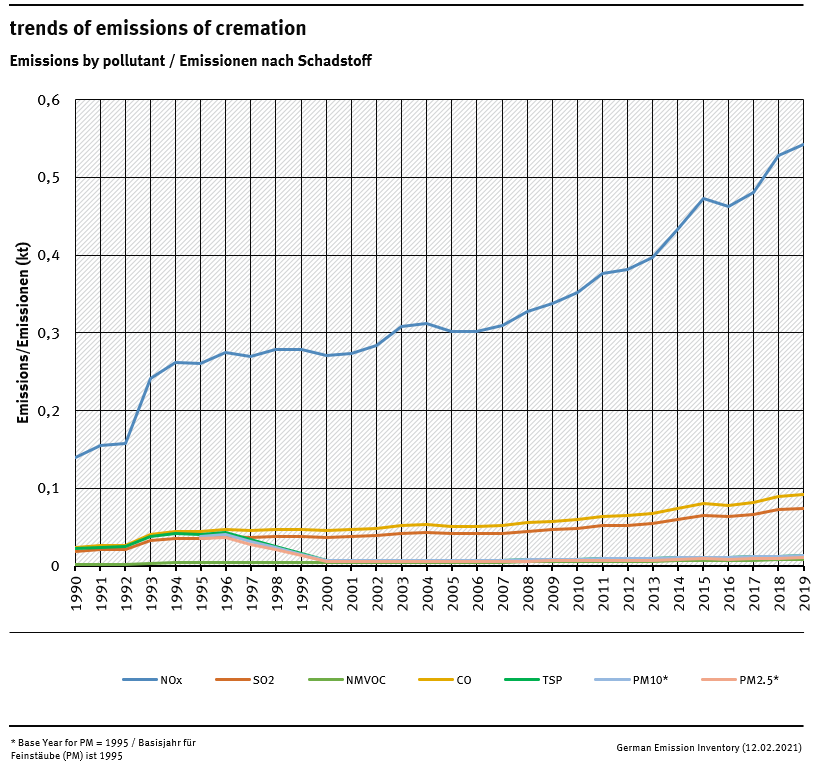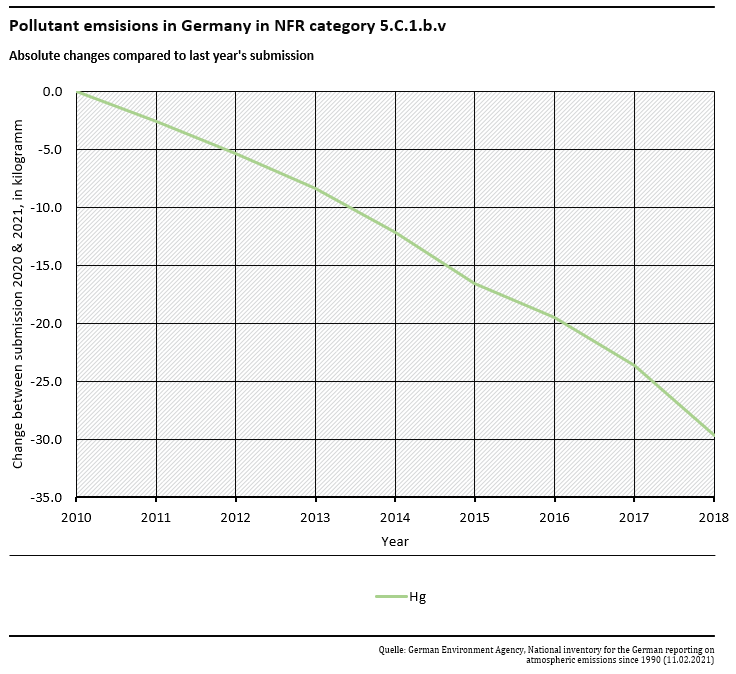meta data for this page
This is an old revision of the document!
5.C.1.b v - Cremation
| Category Code | Method | AD | EF | ||||||||||||
|---|---|---|---|---|---|---|---|---|---|---|---|---|---|---|---|
| 5.C.1.b.v | CS | AS | D, CS | ||||||||||||
| Key Category | SO₂ | NOₓ | NH₃ | NMVOC | CO | BC | Pb | Hg | Cd | Diox | PAH | HCB | TSP | PM₁₀ | PM₂ ₅ |
| 5.C.1.b.v | -/- | -/- | - | -/- | -/- | - | -/- | -/- | -/- | -/- | -/- | -/- | -/- | -/- | -/- |
Method
Emissions from cremation are not a key source and of minor priority. Since March 1997, a national legal ordinance for cremation plants nationwide is in force (27. BImSchV).
Activity data
Activity data for this category are based on data from the statistics of the “Bundesverband Deutscher Bestatter e.V.”1). For purposes of GHG reporting we specify cremations as masses, too. The cremation is a growing trend in funerals.
Emission factors
Emission factors used are default values from the EMEP/EEA air pollutant emission inventory guidebook 2016 2) as well as new national data for POPs from the research project “POP- und Hg-Emissionen aus abfallwirtschaftlichen Anlagen” - Teilvorhaben zum Globalvorhaben „Überprüfung des Standes der Technik der Emissionen prioritärer Schadstoffe für einzelne Industriebranchen (Kleinfeuerungsanlagen und abfallwirtschaftliche Anlagen)“ 3) .
In 2018 the TERT noted that the German Hg EF is 100 times smaller than the default value proposed in the 2016 EMEP/EEA Guidebook and the Cd and Pb EF are 1000 times smaller than the default values proposed in the 2016 EMEP/EEA Guidebook. However, the EF for Pb and Cd are based on national expert judgement: assumption that a) the emissions behave similarly to dust and b) the dust limit value of the air pollution control specification (27th BImSchV) is complied with (to be confirmed on the basis of the new measurement data from 5 crematoria with different exhaust gas cleaning systems). The Hg EF was calculated on the basis of the German report on “OSPAR Recommendation 2003/4 on controlling the dispersal of mercury from crematoria“, but is under evaluation.
Nevertheless a current analysis of measured data could decrease the country specific EF for POP further. After the done finalization of a research Project [FKZ 3716 53 3021 „Umweltrelevanz und Stand der Technik bei Einäscherungsanlagen“ (Environmental relevance and state of the art for cremation plants); URL: https://www.umweltbundesamt.de/publikationen/umweltrelevanz-stand-technik-einaescherungsanlagen] the transparent explanation of this is still outstanding.
EF for TSP, PM10, and PM2.5 derive from the research study “Studie zur Korngrößenverteilung (PM10 und PM2.5) von Staubemissionen” 4).
Trends in emissions
Recalculations
With emission factor of Mercury revised, a small recalculations has been carried out compared to last year's submission.
For pollutant-specific information on recalculated emission estimates for Base Year and 2018, please see the pollutant specific recalculation tables following chapter 8.1 - Recalculations.



